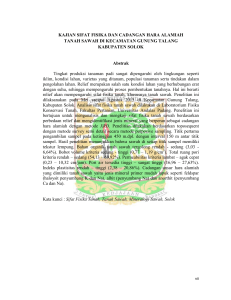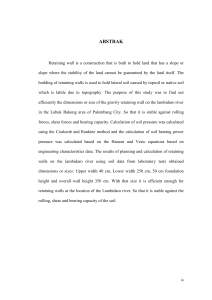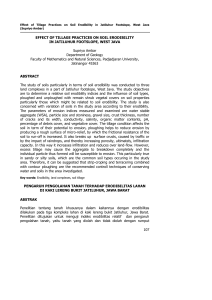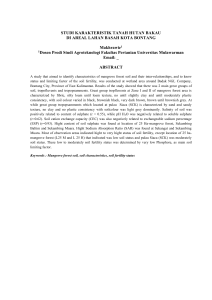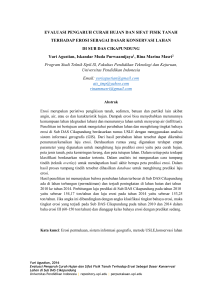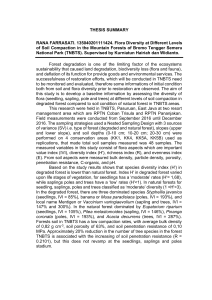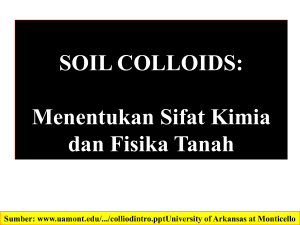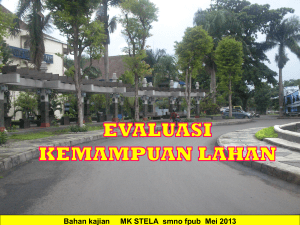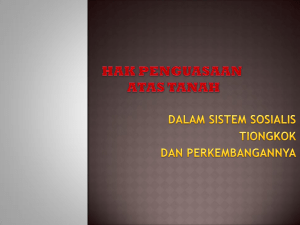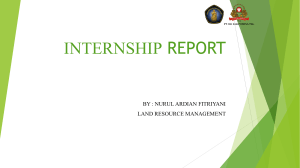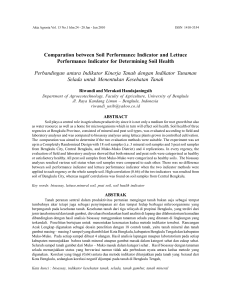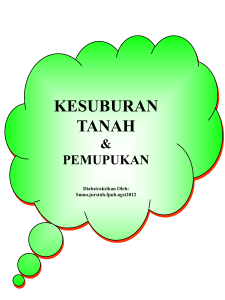Land Classification and Use
advertisement
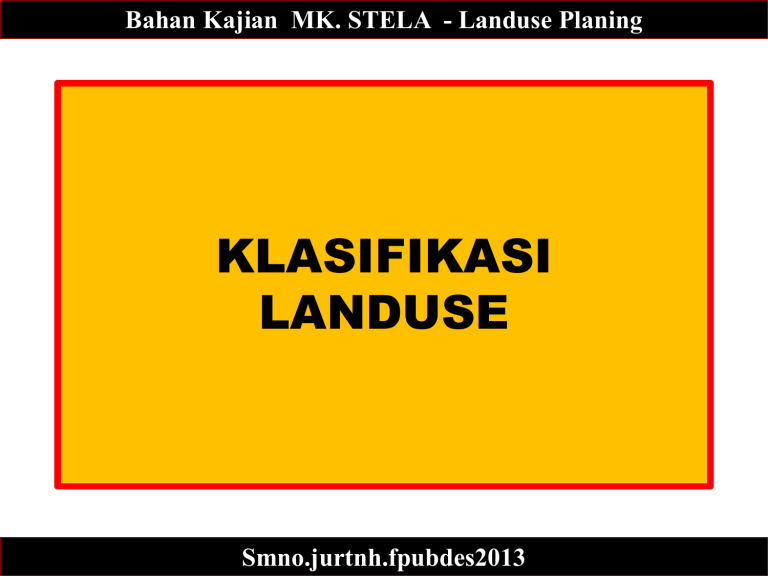
Bahan Kajian MK. STELA - Landuse Planing KLASIFIKASI LANDUSE Smno.jurtnh.fpubdes2013 Land is more than soil 1. Natural and artificial characteristics of an area to be used for agricultural or other purposes 2. Includes renewable and nonrenewable resources plus improvements Land 1. The surface of the earth not covered with water 2. Maybe temporarily or permenently covered with water 3. A pond for aquaculture is considered land Lahan tergenang air hujan secara musiman Lahan Tanaman - Cropland 1. Used for growing crops 2. Crops grown typically improve the tilth of the land Pengolahan tanah untuk memperbaiki kualitas tanah sebagai media tumbuh tanaman Major Characteristics of Cropland 1. Soil - Large impact on productivity. Soil texture, nutrients and internal structure 2. Climate - average of water conditions over a long time 3. Topography - form or outline of the surface of the earth 4. Water supply - amount of water available for crops Major Characteristics of Cropland • Subsurface conditions - Soil textures, hardpans • Pollution - can prevent plant growth Alternative Uses 1. Best land use is determined by how the land will give the most benefits to people. 2. Which use will give the highest returns 3. What will happen if productive cropland is used for other purposes? Konversi lahan sawah menjadi perumahan Land Capability 1. Suitability of land for agricultural uses. 2. Usage should not cause damage to the land although nutients maybe removed Pengelolaan sawah untuk memperbaiki kualitas tanah sebagai media tumbuh bawang merah Lahan Pertanian - Arable land 1. Land that can be used for row crops 2. Can be tilled 3. Alternatives include pasture and forest crops Perbaikan Lahan - Land Improvement Empat praktek pengelolaan lahan pertanian: 1. 2. 3. 4. Irrigation Erosion Control Drainage Forming (land forming)- surface is smoothed or reshaped. Pengelolaan lahan miring untuk memperbaiki kualitas tanah (slope) sebagai media tumbuh sayuran Sifat Olah Tanah - Soil Tilth • Physical condition of the soil that makes it easy or difficult to work – Poor tilth has hard clod – Maybe very wet or very dry Pengolahan lahan dengan sistem guludan untuk memperbaiki kondisi drainage, sebagai media tumbuh tomat Capability Factors Characteristics of land that determine its best use –Surface texture • proportion of sand, silt, clay down to about 7 inches • three major classifications –sandy –loamy –clayey Internal drainage 1. Permeability- movement of water and air through soil 2. Directly related to nutrient content 3. Classified as very slow, slow, moderate and rapid – water quickly soaks into sandy soil with high permeability – soils with clay have slow permeability Kedalaman Tanah - Soil Depth 1. Thickness of the soil layers 2. Requirement depends upon type of crop to be produced 3. Four soil depths are used a. b. c. d. very shallow - less than 10 inches shallow - 10 to 20 inches moderately deep - 20 to 36 inches deep - over 36 inches 4. Shallow soils are often the result of erosion Erosi Tanah 1. Kehilanganb material topsoil oleh angin dan air hujan 2. Empat Kategori: a. very severe erosion- 75% or more and large gullies are present b. severe erosion - 75% of soil has eroded but no large gullies present c. moderate erosion- 25 to 75% of soil has eroded with small gullies present d. none to slight erosion - less than 25% of soil has eroded and no gullies are present Kemiringan - Slope 1. The rise and fall of the elevation of the land 2. Diukur dalam Persen (%) 3. Important in determining the best use of the land Limpasan Permukaan - Surface Runoff • Water from rain, snow, or other precipitation that does not soak into the ground • Can be reduced by conservation practices – chopping stalks – terraces – ground cover Pengolahan lahan dengan mulsa plastik untuk konservasi lengas tanah bagi tanaman tomat Kelas Kapabilitas Lahan 1. 2. 3. 4. 5. Assigning a number to land Eight classes used I to VIII with I being the best arability Class I to IV can be cultivated V to VIII tend to have high slope or low and wet Kelas-Kelas • Class I - Very good land – Very few limitations – deep soil and nearly level – can be cropped every year as long as land is taken care of • Class II - Good land – has deep soil – may require moderate attention to conservation practices • Class III - moderately good land – crops must be more carefully selected – often gently sloping hills – terraces and stripcropping are more often used • Class IV - fairly good land – lowest class cultivated – on hills with more slope than class III • Class V - Unsuited for cultivation – can be used for pasture crops and cattle grazing, hay crops or tree farming – often used for wildlife or recreation areas • Class VI - Not suited for row crops – too much slope – usually damaged by erosion with gullies – can be used for trees, wildlife habitat, and recreation • Class VII - Highly unsuited for cultivation – has severe limitations – permanent pastures, forestry, wildlife – slope is usually over 12 percent – large rock surfaces and boulders may be found – very little soil present Class VIII 1. Cannot be used for row crops or other crops, due to steeping land 2. often lowland covered with water 3. soil maybe wet or high in clay 4. aquatic crops maybe grown there 5. used for waterfowl habitat
